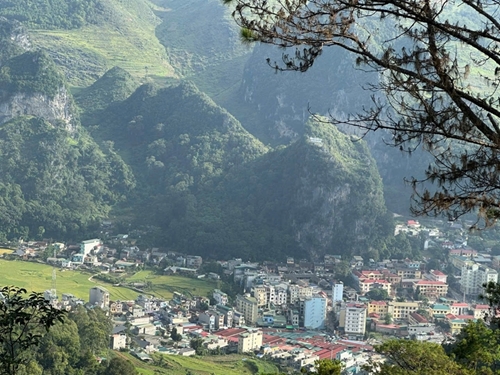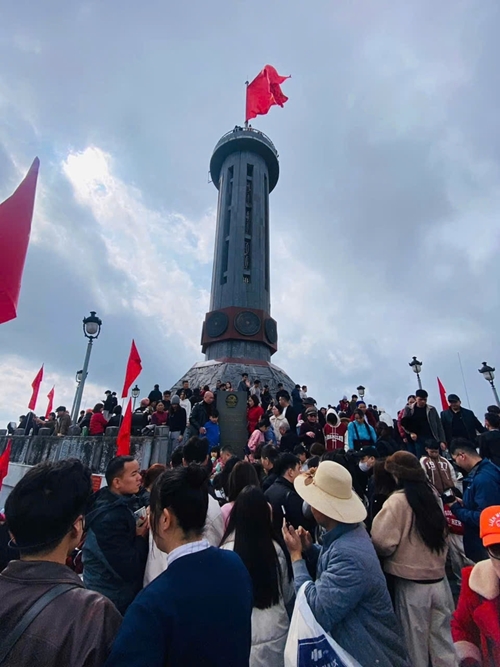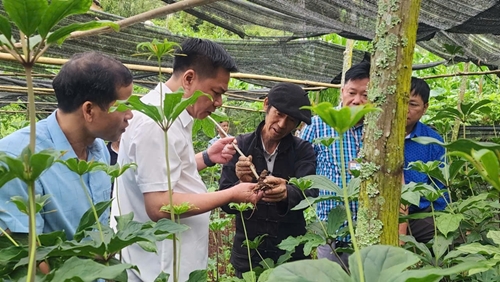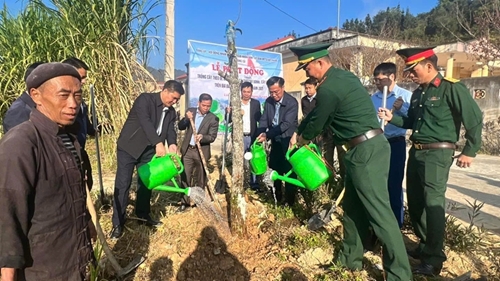A land rich in tourism potential
As the important part of the Dong Van Karst Plateau UNESCO Global Geopark, Dong Van district is situated an average altitude of 1,400 meters above sea level and has a total area of 45,171 hectares.
    |
 |
|
A corner of Dong Van town |
In addition to its majestic, pristine, and unique natural landscapes, cool and fresh climate, the area boasts rich traditional cultural values, with 17 ethnic minority groups living here, including the H'mong, Dao, Tay, Kho Lao, Lo Lo, and Pu Peo. These ethnic groups live harmoniously and together create distinct cultural identities that characterize the highland plateau.
Currently, Dong Van has 14 clusters with 68 geological and geomorphological heritage sites, along with 16 recognized cultural and scenic landmarks, eight of which are national heritage sites and eight provincial heritage sites. The Dong Van Karst Plateau is also known as the "Ha Long Bay on land."
In addition to famous landmarks such as Lung Cu Flagpole, the ancient architecture of Dong Van Old Quarter, and the architecture of the Vuong Mansion, Dong Van is home to several renowned sites, such as the Tham Ma Pass, the Nine Loops Pass, the Sung La Valley, the Thien Huong Forest, and the Northernmost Point at Lung Cu.
According to Secretary of the Dong Van district’s Party Committee Nguyen Tien Dung, Dong Van defines tourism development as a key task and a breakthrough in the local economic development strategy toward sustainability. It aims to maximize the district’s potential and advantages; promote traditional culture, natural landscapes, and indigenous architecture; combine the preservation and enhancement of cultural values with protecting the natural environment. He added that the locality focus on combining agricultural development with tourism and vice versa.
Dong Van is determined to build a brand for its tourism, making it a safe, attractive, and distinctive destination in the Northern region of Ha Giang, with the goal of transforming from a poor district into a more economically-developed one.
    |
 |
|
Tourists visit Lung Cu Flagpole. |
Breaking the "bottleneck" - Stimulating tourism
Identifying tourism development as a priority, in 2024, the district has reviewed 23 potential tourism hotspots to invest in. However, due to limited resources, the district has focused on 11 urgent projects in 2024, with the remaining projects planned for 2025-2026 period.
To carry out the projects, the district has called for and attracted investment, implementing several initiatives through socialized funding. By creating consensus among the local people and businesses, the district has mobilized nearly VND 2 billion VND. Notably, locals people and businesses contributed working days and funding to build stone gateways in Dong Van townlet, Pho Bang, Sung La, and stone walls along National Road 4C leading to the town center.
In communes like Sung La, Pho Bang communes and Dong Van townlet, the district has completely socialized the investment of VND 1.3 billion to construct 32 kiosks and stalls with traditional local architecture. This socialization effort has been made possible by the consensus of the local people and businesses to develop tourism highlights with local party committees and authorities.
    |
 |
|
Secretary of Dong Van district’s Party Committee Nguyen Tien Dung (in white) visiting people in border commune of Pho La |
The construction of these tourism highlights not only brings economic benefits to local people but also preserves and promotes the unique cultural heritage of the ethnic groups in the Dong Van Karst Plateau.
Towards green, clean, and sustainable tourism
In addition to these projects, the district has fostered tree planting to create four-season flower tourism sites. Over 1,000 local pear and peach trees have already been planted, and more than VND 1.3 billion has been raised through socialization for the landscaping project.
In agriculture, the district has prioritized the development of "5 crops, 5 livestock," which includes pears, buckwheat, cabbage, Khau Mang rice, and plums, as well as livestock such as cows, pigs, goats, bees, and chickens. The district has also coordinated with enterprises, restaurants, and hotels to connect agricultural production with the tourism supply chain. The district is effectively implementing the "One Commune, One Product (OCOP)" program, with 25 certified products and 10 new OCOP products in 2024, including pear products, buckwheat wine, pear jam, ginseng products, buckwheat beer, and various processed products from pork, beef, honey, and ginger.
    |
 |
|
Dong Van district’s leaders, troops and people planting trees |
In addition, the district formed Tourism Advisory and Information Service Team and a Tourism Association, which is seen as a trusted "red address" for tourists. Furthermore, the district has revamped its website and issues a tourism guidebook. The district has cooperated with Ha Giang Newspaper and the provincial Radio and Television to boost dissemination, contributing to the success of the Street Festival, H’mong Flute Festival, and Buckwheat Flower Festival. As a result, the number of visitors to Dong Van has increased, reaching over 700,000 in 2023 and over 900,000 in 2024. Total revenue from accommodation and food services is expected to exceed VND 1.2 trillion in 2024.
According to the district’s Party Secretary Nguyen Tien Dung, in the future, Dong Van will continue to introduce new tourism products. Visitors will be able to experience the largest performance center on the Dong Van Karst Plateau, ride horses or horse-drawn carts to tourist destinations, and explore local villages.
In addition, with the region's famous pear and peach blossoms every spring, Dong Van plans to organize new festivals in 2025, such as the Pear Blossom Festival and Peach Blossom Festival, together with the Buckwheat Flower Festival. The district will also prioritize tourism and service development, aiming to improve the quality of service for visitors, making Dong Van a "safe, attractive, and friendly" destination with a distinctive brand and identity.
Translated by Tran Hoai